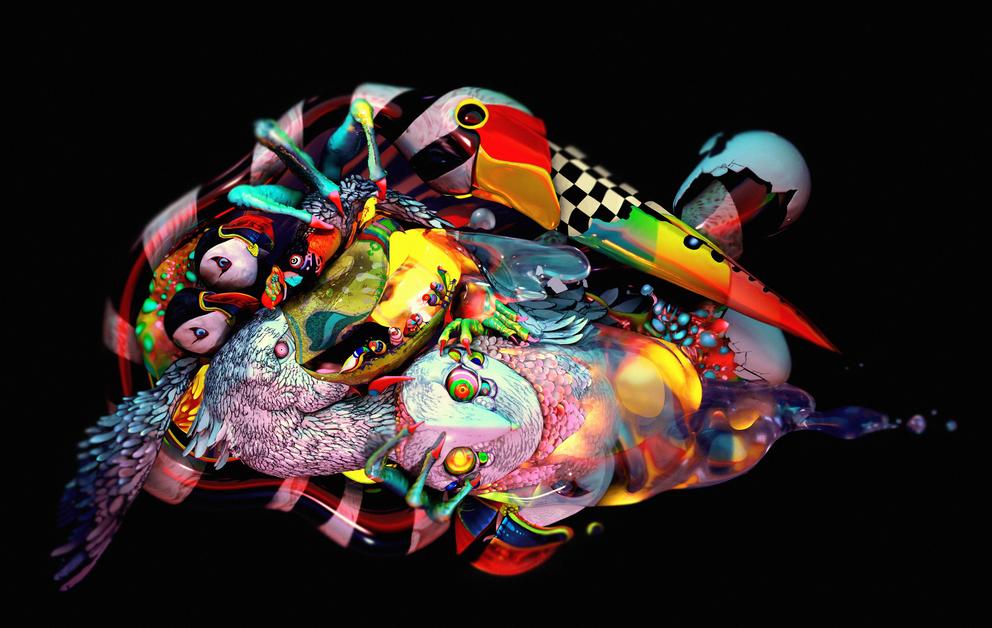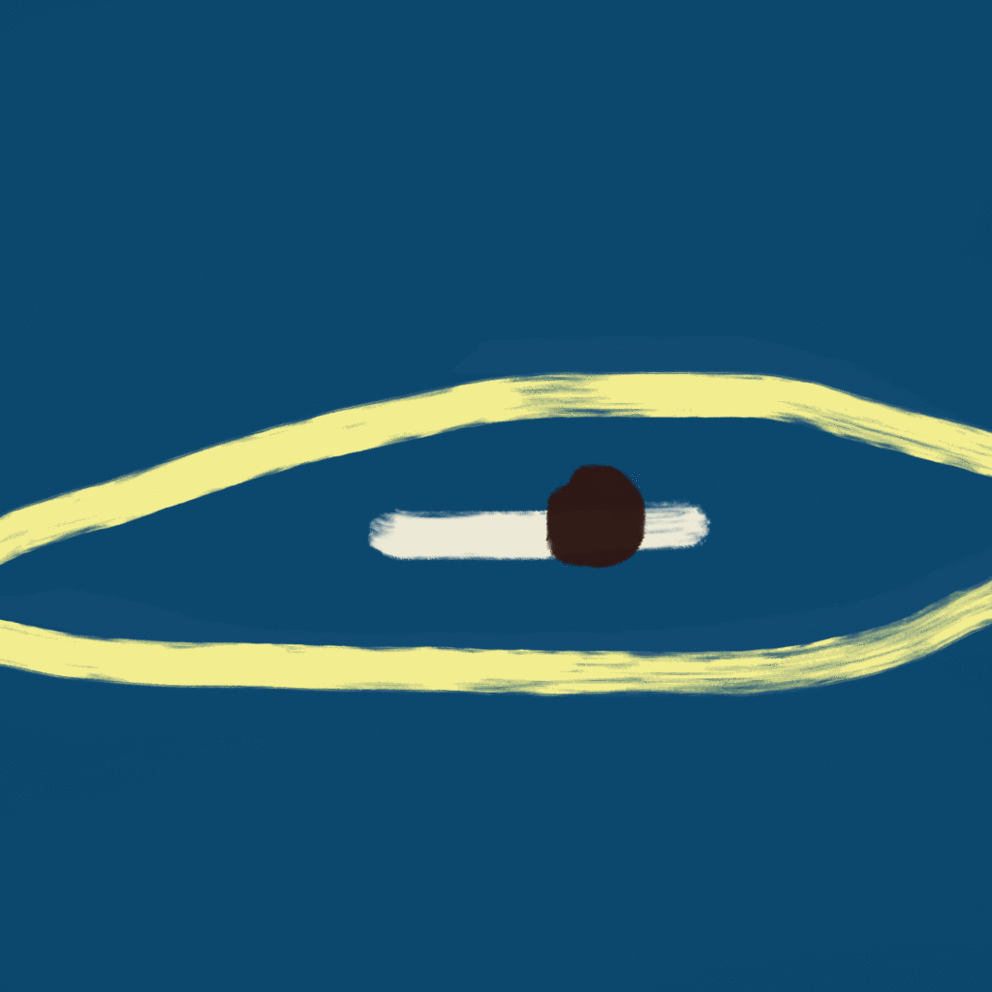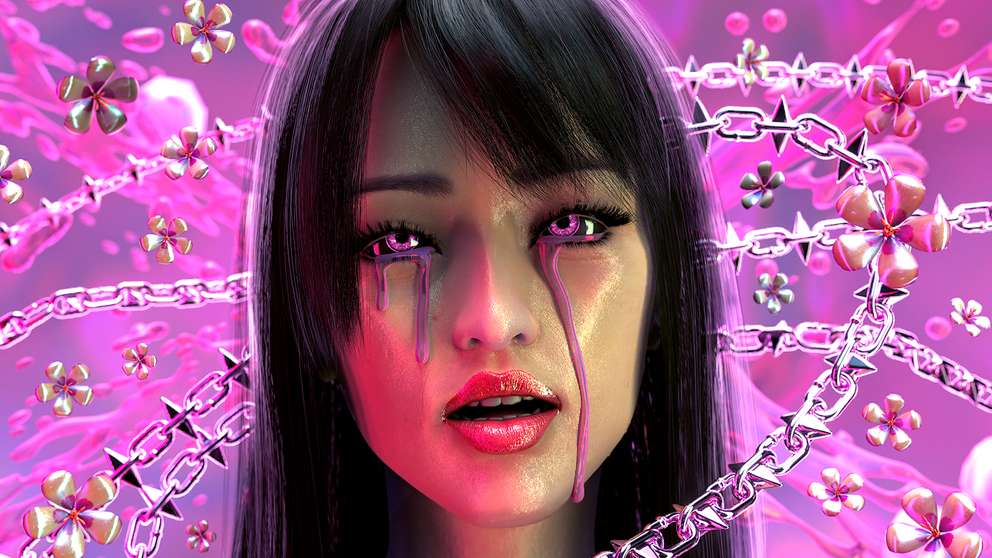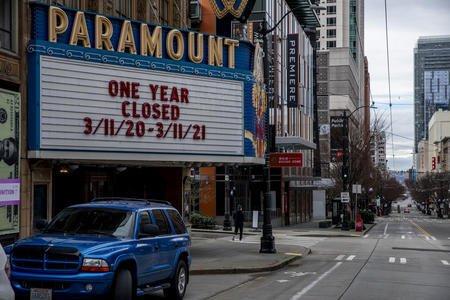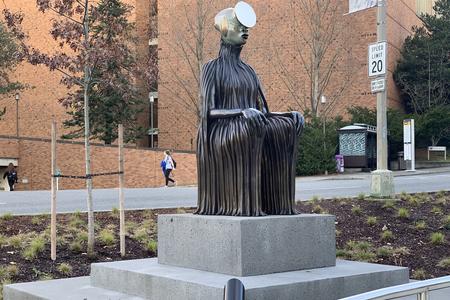Since then, FEWOCiOUS (who did not respond to an interview request) has made hundreds of thousands more from online sales of his work. This recent success has brought the self-taught artist internet fame, multimillion-dollar sneaker “collabs” featured in the Wall Street Journal and helped him realize his dream of moving from Las Vegas to Seattle. Here, he’s part of the growing cadre of young artists who are monetizing their digital art by way of cryptocurrency — and in the process, kicking the “starving artist” cliché squarely in the solar plexus.
What’s remarkable is not just the age contingent and price range of this new art market, but that all of this is happening on entirely digital platforms. Welcome to the booming — and controversial — world of crypto art.
These artists, raised on the internet, create pieces with digital brushes and 3D sculpting tools and save them as GIFs, MP4s or JPEGs. The works are then uploaded, purchased, collected and traded online as NFTs, non-fungible tokens — a digital certificate of authenticity — via blockchain, the technology behind Bitcoin and other cryptocurrencies, such as Ether (ETH) of the blockchain Ethereum.
“NFTs have been a thing for years, but recently it's been exploding,” says Seattle-based digital sculptor Sam Clover, aka Planttdaddii. Clover started selling her artworks — GIFs and JPEGs of psychedelic flora and fauna — as NFTs in October last year. These days, her works routinely sell for 2 ETH (more than $3,000) on platforms like SuperRare and Foundation.
“For the last four years, I have been making what I make with no expectation of anything in return, just doing it because I like it,” Clover says of her digital artworks. “So this is all just extremely surreal — that I have a catalog of work that is now worth a lot of money.”
“I’ve never felt financial stability in my life,” she adds. ”Every single day I wake up, like: ‘What is going on?’ And it keeps getting crazier.”
Seattle 3D sculptor Sam Clover, aka Planttdaddii creates virtual sculptures featuring trippy fauna and flora through tedious work with 3D software. This piece, called "Feathered Friend," sold as an NFT on SuperRare for 1.7Ξ ($2,505). (Sam Clover/Planttdaddii)
Though the NFT technology is not new, the crypto art scene started heating up mostly this past year. The recent headline-grabbing sale of a JPEG file at auction house Christie’s poured fuel on the fire. The artist known as Beeple scored $69 million for a digital collage of 5,000 images he created over the last 14 years — and set a record as the third-highest auction price ever achieved for a living artist, after Jeff Koons and David Hockney. Cue the NFT gold rush.
It was a perfect storm of trends already in motion. In recent years, the art market has become increasingly global, young and online (a shift amplified by the pandemic). In the past century, art has also become more of a commodity, thanks in part to a growing class of wealthy people investing in art as another portfolio asset.
The Beeple sale at the 254-year-old auction house gave NFTs a stamp of mainstream approval, even as criticism of its disastrous environmental footprint and financially speculative nature mounts. According to NFT market tracker Nonfungible.com, more than $200 million has been spent on NFT-based art in the past month alone, compared with $250 million total in 2020.
Though the phrase “crypto art” may conjure hyped-up video game aesthetics, that’s just one small slice of the breadth of artwork out there. Yes, you’ll find trippy, hypnotizing New Age visuals, but also highly stylized 3D renderings of blocks and spheres, intricate Pre-Raphaelite-esque tableaus, memelike cartoonish drawings and even scanned, hand-drawn works that almost feel artisanal amid all the digital hubbub.
Everyone seems to want a piece of the pie: pop star Grimes, the National Basketball Association, rock band Kings of Leon, rapper Ja Rule (of the failed Fyre festival) and actress Lindsay Lohan have all sold music, photos or videos as NFTs. Remember that viral TikTok video of the man vibing to Fleetwood Mac on his skateboard? He’s putting it up for sale as an NFT (but without the music, due to a copyright issue — which hints at the intellectual property complications on the NFT horizon).
In the tech-heavy Puget Sound region, a growing group of local artists and entrepreneurs is also jumping into the fray.
“It’s gone mainstream now,” says Nathaniel Parrott, another local digital artist (and friend/collaborator of FEWOCiOUS) who’s been making digital works for years and started selling them as NFTs about a year ago. “My parents, my girlfriend, my girlfriend’s parents and sister are all buying art on NiftyGateway now — which is a plot twist I didn’t see coming.”
This looping animation and accompanying original musical composition titled "The Initiation" was made by local artist Nathaniel Parrott and is currently owned by the (virtual) Museum of Crypto Art. (Nathaniel Parrott)
The concept of NFTs can be tough to wrap your head around because even if someone else owns the NFT, these images and videos are available to anyone with an internet connection. Any non-owner could download one onto their phone, or use the image as a screensaver.
What an NFT purchase gets you is not the artwork but the (proof of) ownership. It’s like a deed, except instead of a paper bill of sale, it’s recorded on the blockchain, a sort of giant virtual ledger that tracks how goods exchange hands. Or maybe it’s more like a master recording of an MP3 file that everyone listens to, or a web domain everyone visits but only one person owns.
“With NFTs, it’s less about looking at the art every day like you would hang on your wall. It’s more [about] the concept of ownership and collectibles,” Parrott, who also goes by Parrott_ism, says. “There’s a certain feeling that you get when you think: ‘Oh, I own that.’ ”
NFTs make possible what wasn’t possible, and perhaps wasn’t imaginable before: Owning and monetizing the original of a digital file repeated in unknown multiples across the web. This has meant that digital artists can put a price tag on their art — many for the first time — which is suddenly a hot commodity.
Besides being lucrative, it’s been artistically liberating for Parrott. For years, he thought his only avenue to make a living as a digital artist would be as a video game and movie designer, following artistic edicts of corporations. “It’s the first time I've felt like an actual artist,” he says. “There’s a very strong sense of validation.”
Clover, for one, says she is experiencing “overwhelming guilt” about her personal success (and plans to funnel some of the money back to other up-and-coming artists). But she can’t help but feel excited, too. “It’s changing the way people buy art. It's cutting out the middleman. It's empowering artists,” she says.
Nathan Chan, the assistant principal cellist at the Seattle Symphony, is collaborating with Lia Coleman, a local machine learning artist and developer on a series of NFTs combining music and artificial intelligence-generated animation. This work, "Flowers Makin Whoopee," is currently for sale on the crypto platform hic et nunc. You are also hearing Andy Liang, First Violin at the Seattle Symphony, on violin. (Lia Coleman/Nathan Chan/Andy Liang)
Although NFT evangelists tout the technology as an equalizer, there are still middlemen. Artists pay fees to offer their work on platforms like Nifty Gateway, SuperRare, OpenSea and Rarible, though the cost is often less than the standard 50% cut many galleries take. Artists can also profit when an artwork gets resold from collector to collector, 10% usually, sometimes more. That’s basically unheard of in the brick-and-mortar art world. (If I buy a painting from a gallery, the artist gets her cut. If I later sell it on eBay, the artist gets nothing.)
“A lot of artists get hooked with the chance to get royalties on their secondary sales,” says Seattle-based (paper) printmaker Ken Ballard, who recently started to collect NFTs and is working on his first “drop” of NFTs, a series of digital, moving images accompanied by his own sound collages. “It’s opening up a revenue stream for artists. And I think it clicks because arts, especially in this country, are way underfunded…. Artists haven't really been able to get paid for their work like this.”
It’s also allowing tech-savvy entrepreneurs and others to cash in by trading this digital art like baseball cards or other so-called “collectibles.” Critics say it’s a speculative feeding frenzy that, much like the recent “meme stock” hype, won’t last. And even artists like Beeple are expecting the market to settle and prices to drop.
“The explosion of NFT marketplaces feels like the hype around 1990s virtual reality or when the Segway was introduced,” says Seattle artist and designer Janet Galore, whose artwork explores the complexities of the digital age. “We are at the very beginning of NFTs; how they eventually will work will likely be pretty different.” Right now, she says, they're rife with problems.
“The situation smacks of pyramid schemes, where hypercapitalists, with power and resources to mine cryptocurrency…are the primary profiteers,” she says.
That hasn’t stopped Galore from dipping her toes into the market, however. “I’m playing along with NFTs as an experiment to understand more deeply what might be required to make these systems equitable and sustainable long term,” she says. Galore purchased her first NFT, a work by local artist Carolyn Hitt, for 0.1 ETH — roughly $182 at the time, plus $79 in transaction and other fees. “I’d rather give that cash to a gallery owner, or more to the artist,” Galore says.
Local abstract expressionist artist Carolyn Hitt recently made this moving "Animediation 008" as an NFT. (Carolyn Hitt)
Hitt, an abstract-expressionist multimedia artist offline, has put a few of her digital works for sale on the OpenSea platform. Much of that work builds on the style of her canvas paintings, though in cyberspace the lines can move, grow like flowers and ripple like waves in animated GIFs Hitt calls “Animeditations.” Prices hover near 0.02 ETH or $35.83 (at the time of this writing).
Hitt has been an artist for much longer than many of the younger, up-and-coming artists fetching hundreds of dollars per piece. Some of their success comes from having jumped into the scene “early,” in 2020 — before the hype exploded, creating connections with collectors when things still felt small. Many curated platforms now have huge waitlists for artists hoping to sell their work.
Local artist Lindon Schaab, who goes by GHØST GIRL, says having a social media following helps.
“What I find typically defines the price of an NFT is how popular you are,” she says, along with supply and demand. But when pricing her work, Schaab also looks at the hours of work it took to make and the variety of media used. “Is it animated? Does it have sound? Those take a lot of time because, if you think about it: A 3D animation is just thousands of still images, so it’s technically doing the same thing an exponential amount of times.”
This kind of tedious work requires skills, and most artists I spoke with had honed their craft over years. That’s why it’s so hurtful to hear the common reproach that it’s “not real art,” says artist Hannah Selene. “We spend so much time with these pieces. It’s hard. It’s a labor of love.”
"I'm really happy because I've never really had a livable wage with art," says local artist Lindon Schaab, aka GHØST GIRL about her venture into NFTs. "I've been in pretty deep poverty — typical starving-artist stuff." (Lindon Schaab)
Kirkland-based artist Keegan Hall is known for his hyperrealistic pencil drawings of sports events and celebrities. While he’s putting pencil to paper in his studio, he listens to discussions about NFT art for six-plus hours a day on social audio app Clubhouse. He’s currently working on his first NFT, which may be an animation of himself drawing that will come with a physical counterpart (such as a paper drawing). But Hall doesn’t think physical art will disappear. “It’s not an either-or when it comes to art,” he says. “It's just another tool in the toolkit. Another outlet.”
That’s very much the case made by Nathan Chan, the 27-year-old assistant principal cellist at the Seattle Symphony. He’s collaborating with Lia Coleman, a local machine-learning artist, developer, and adjunct professor at the Rhode Island School of Design, on a series of NFTs combining music and artificial intelligence-generated animation. Just last week, the duo minted their very first NFT, called “Listener Interspace,” which they say is “inspired by the lightning speed of the crypto space and the chaotic glitchiness of life and technology.”
For their second NFT, Coleman trained an artificial intelligence network to create visuals based on 14,000 images of flowers, making them move, wilt and bloom to the jazz standard “Makin’ Whoopee” on cello and violin (played by Chan and Andy Liang, first violin at the Seattle Symphony).
“It’s this happy marriage between old and new,” Chan says. “NFTs have made this new type of artwork possible. What interests me the most is that we’re going to see a whole ‘nother genre of creativity.”
Their NFTs are available in an edition of 10 (25 Tezos; about $100 per piece), a common arrangement in the NFT world. Less common: The NFT is available on the Tezos blockchain, which is considered more ecologically friendly than Ethereum.
The hefty carbon footprint is perhaps the most well-publicized problem with NFTs (and blockchain in general). It’s hard to overstate just how harmful NFTs are to the environment because of the staggering amount of electricity it takes to run blockchain, which generates greenhouse gas emissions. According to estimates from Digiconomist, a platform monitoring “unintended consequences of digital trends,” one single Ethereum transaction is equivalent to an average U.S. household’s power consumption over 2.18 days, making its carbon footprint equivalent to 67,820 Visa transactions, or 5,100 hours of watching YouTube.
NFT defenders contend that shuttling artwork and people across the globe for art fairs and exhibits is also taxing on the environment. Plus, Selene says: “I don’t think that the blame should be passed on to the creators; I think the blame is [on] the technology aspect itself.”
This artwork by Sam Clover, titled "unconditional," was sculpted with digital tool ZBrush and rendered with 3D software. “A lot of people, even older generations, kind of understand that everyone's on their phone all the time, everything's digital," says Clover about the NFT trend. "There's bound to be a fundamental shift in the way people consume [art].” (Sam Clover)
Some artists have started minting their NFTs on the smaller and more environmentally friendly marketplaces popping up, but many haven’t made the move yet. The question is what it will take for artists to move en masse to using them. Chan and Coleman hope their decision to use a cleaner blockchain raises awareness about the options beyond Ethereum. “It’s very important to consider: ‘Which path do we take in terms of the ecological impact?’ We are deciding what future we want to build,” Coleman says. “We should think about which avenues we want to take to get there.”
Some think carbon offsets are the answer. Kirsten Anderson of longtime Seattle gallery Roq La Rue is working with entrepreneur Art Min (who previously ran the Paul G. Allen Family Foundation at Vulcan) to launch a curated NFT art platform called Phosphene. The platform will buy carbon offsets and invest in so-called “carbon-scrubbing” technology to be carbon negative, Anderson says. (Still, carbon offsetting is a flawed mechanism that doesn’t solve as much as people would like to believe, experts say.)
“There is a whole sea of collectors who are on the younger side, they have tech money, and they’re used to buying things within the digital world,” Anderson says. “The [local] art community’s big conversation has been: How do we bring in the tech money? How do we get tech collectors? This is how you do it because that’s what they understand — this is their language.”
Phosphene’s first launch, in April, will be a series of NFTs by Electric Coffin, a local artistic duo known for their pop art installations and multimedia branding artwork. They’ll offer up one of their Sweet Savage Love Tiger images (in this case, a tiger with a truck on its back) as a digital NFT, as well as a few others as editions. The duo is currently debating whether to offer the physical artwork (hand-painted and screen printed on glass) with the sale. Another other option: smashing it, so only its digital version remains.
Min sees even more options ahead. In the future, an NFT might come with a ticket to a gallery opening, for example. “There’s a lot of potential in activating those inherent capabilities of crypto blockchain and technology to lift up the art community and realize new opportunities,” he says.
Crypto-art believers promise this is just the beginning. From special holographic screens that display NFTs as three-dimensional art on your wall at home to virtual art galleries and museums you can visit by popping on a virtual reality headset — much more is to come.
“As soon as these virtual reality worlds really go mainstream, that’s where all this artwork is going to end up. It’s going to be ported right on to your VR …, a gallery in virtual reality,” says artist Ken Ballard.
The dream, says artist Hannah Selene, is to go even further and create another art realm altogether. “Digital art enables these 360-degree creations of other worlds and environments,” she says. “The creative possibilities are endless.”
Get the latest in local arts and culture
This weekly newsletter brings arts news and cultural events straight to your inbox.

